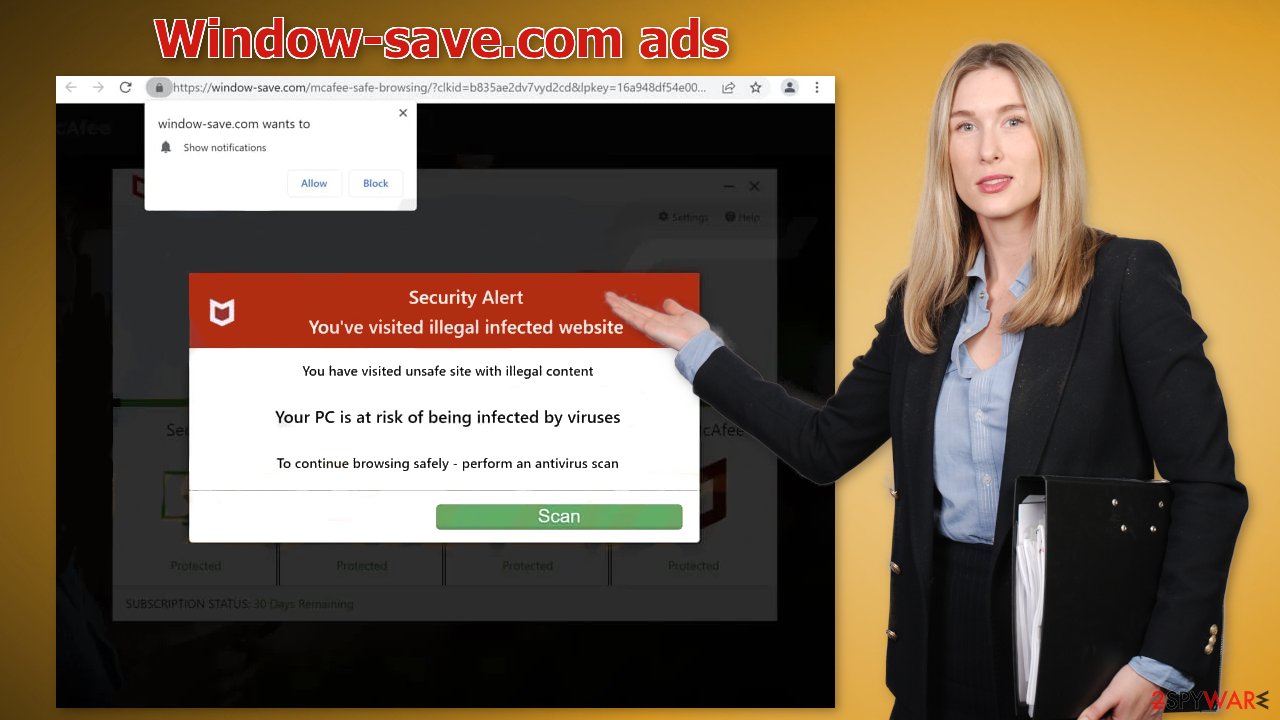Window-save.com ads (fake) - Free Guide
Window-save.com ads Removal Guide
What is Window-save.com ads?
Window-save.com wants to display notifications that look like security alerts from “McAfee”

Window-save.com is a bogus website that is designed to look like a security alert from a well-known security suite known as “McAfee.” There should be no doubt in anyone's mind that they are not related to this fraudulent campaign in any shape or form. Crooks are using the name of the antivirus software to look legitimate and gain users' trust while they flash a false message on the screen.
| NAME | Window-save.com |
| TYPE | Push notification spam; adware |
| SYMPTOMS | A page appears seemingly out of nowhere warning users about virus infections; users may start seeing pop-ups that look like security alerts; |
| DISTRIBUTION | Shady websites; deceptive ads; bundled software |
| DANGERS | People may be tricked into providing personal information, downloading potentially unwanted programs, or even malware |
| ELIMINATION | Disable push notifications in the browser settings; run a system scan with professional security tools |
| FURTHER STEPS | Use FortectIntego to fix any remaining damage and optimize the machine |
Window-save.com overview
Fraudsters try to convince people that their PC is infected with multiple viruses and that their security software subscription has ended. The full message that users see reads as follows:
You have visited unsafe site with illegal content
Your PC is at risk of being infected by viruses
To continue browsing safely – perform an antivirus scan
If people choose to “perform an antivirus scan,” the deceptive website proceeds to show fake animations that give the impression that the page is performing a system scan. Keep in mind, that websites cannot scan or inspect your computer. After the “scan” is done, it is determined that users need to install a tool to take care of potential threats.

The danger of fake security alerts
It is unknown if the software that Window-save.com wants people to install is safe. Usually, crooks try to trick people into downloading PUPs (potentially unwanted programs),[1] or even malware. They can disguise adware, browser hijackers, as “handy” tools so that regular users would not suspect them to be malicious.
Scammers also do not really care about user privacy or security, so often they use rogue advertising networks that place ads leading to dangerous websites. As a result, links embedded in the push notifications can land people on sites that use social engineering methods.
Users can not only infect their machines but also suffer from monetary losses and identity theft if they provide personal information to unsafe sources. One of the most annoying things that might happen after your data lands in the wrong hands is spam calls, and emails.
Distribution tactics
Usually, users do not stumble upon scam sites in their search results. Normally, they hide in other shady sites behind deceptive ads, sneaky redirects, fake “Download” and “Play” buttons. For example, illegal streaming platforms are unregulated, so they are breeding grounds for all fake websites, like human verification scams.
However, such pages can also appear without any user input. Adware is a type of PUP that can generate commercial content on the machine. Most users, do not notice such infections until it has already started performing unwanted tasks. So, it is very possible that the deceptive page opened automatically.
Fix your browsers
To stop annoying virus alerts from Window-save.com, you have to block the site permissions that allow it to show you push notifications. After removal is complete, we recommend using FortectIntego repair tool to care for your browsers. Almost every website you visit uses cookies[2] to track your browsing activity, like the pages you visit, links you click on, and purchases you make.
If you have pop-ups appearing from questionable sources it most likely means that you were surfing through web pages you should not and clicked on dangerous links. Your browsing data might be exposed or sold to advertising networks that use it to target you with ads even more. But first, you have to stop the pop-up ads from appearing. You can do that by following our step-by-step guide:
Google Chrome (desktop):
- Open Google Chrome browser and go to Menu > Settings.
- Scroll down and click on Advanced.
- Locate the Privacy and security section and pick Site Settings > Notifications.
![Stop notifications on Chrome PC 1 Stop notifications on Chrome PC 1]()
- Look at the Allow section and look for a suspicious URL.
- Click the three vertical dots next to it and pick Block. This should remove unwanted notifications from Google Chrome.
![Stop notifications on Chrome PC 2 Stop notifications on Chrome PC 2]()
Google Chrome (Android):
- Open Google Chrome and tap on Settings (three vertical dots).
- Select Notifications.
- Scroll down to Sites section.
- Locate the unwanted URL and toggle the button to the left (Off setting).
![Stop notifications on Chrome Android Stop notifications on Chrome Android]()
Mozilla Firefox:
- Open Mozilla Firefox and go to Menu > Options.
- Click on Privacy & Security section.
- Under Permissions, you should be able to see Notifications. Click Settings button next to it.
![Stop notifications on Mozilla Firefox 1 Stop notifications on Mozilla Firefox 1]()
- In the Settings – Notification Permissions window, click on the drop-down menu by the URL in question.
- Select Block and then click on Save Changes. This should remove unwanted notifications from Mozilla Firefox.
![Stop notifications on Mozilla Firefox 2 Stop notifications on Mozilla Firefox 2]()
Safari:
- Click on Safari > Preferences…
- Go to Websites tab and, under General, select Notifications.
- Select the web address in question, click the drop-down menu and select Deny.
![Stop notifications on Safari Stop notifications on Safari]()
MS Edge:
- Open Microsoft Edge, and click the Settings and more button (three horizontal dots) at the top-right of the window.
- Select Settings and then go to Advanced.
- Under Website permissions, pick Manage permissions and select the URL in question.
- Toggle the switch to the left to turn notifications off on Microsoft Edge.
![Stop notifications on Edge 2 Stop notifications on Edge 2]()
MS Edge (Chromium):
- Open Microsoft Edge, and go to Settings.
- Select Site permissions.
- Go to Notifications on the right.
- Under Allow, you will find the unwanted entry.
- Click on More actions and select Block.
![Stop notifications on Edge Chromium Stop notifications on Edge Chromium]()
Scan your machine with anti-malware tools
If you disabled push notifications but still experience unwanted symptoms like unexpected redirects and an increased amount of commercial content, like pop-ups, and banners you should scan your system for adware. It is mostly spread on freeware[3] distribution sites. They include additional programs in the installers and do not disclose it clearly on their pages.
We suggest using trusted professional security tools SpyHunter 5Combo Cleaner or Malwarebytes for PUP removal. It should detect most suspicious apps and remove them successfully. Of course, you can also remove a PUP manually, but it is unknown which particular app could be causing annoying behavior, as crooks disguise them as “handy” tools. Manual uninstallation can also leave some traces of the program behind which could result in the renewal of the infection.
However, if you still do not want to use security tools and know which program is at fault, use the instructions below to help you uninstall it:
Windows 10/8:
- Enter Control Panel into Windows search box and hit Enter or click on the search result.
- Under Programs, select Uninstall a program.
![Uninstall from Windows 1 Uninstall from Windows 1]()
- From the list, find the entry of the suspicious program.
- Right-click on the application and select Uninstall.
- If User Account Control shows up, click Yes.
- Wait till uninstallation process is complete and click OK.
![Uninstall from Windows 2 Uninstall from Windows 2]()
Windows 7/XP:
- Click on Windows Start > Control Panel located on the right pane (if you are Windows XP user, click on Add/Remove Programs).
- In Control Panel, select Programs > Uninstall a program.
![Uninstall from Windows 7/XP Uninstall from Windows 7/XP]()
- Pick the unwanted application by clicking on it once.
- At the top, click Uninstall/Change.
- In the confirmation prompt, pick Yes.
- Click OK once the removal process is finished.
Mac:
- From the menu bar, select Go > Applications.
- In the Applications folder, look for all related entries.
- Click on the app and drag it to Trash (or right-click and pick Move to Trash)
![Uninstall from Mac 1 Uninstall from Mac 1]()
To fully remove an unwanted app, you need to access Application Support, LaunchAgents, and LaunchDaemons folders and delete relevant files:
- Select Go > Go to Folder.
- Enter /Library/Application Support and click Go or press Enter.
- In the Application Support folder, look for any dubious entries and then delete them.
- Now enter /Library/LaunchAgents and /Library/LaunchDaemons folders the same way and terminate all the related .plist files.
![Uninstall from Mac 2 Uninstall from Mac 2]()
How to prevent from getting adware
Stream videos without limitations, no matter where you are
There are multiple parties that could find out almost anything about you by checking your online activity. While this is highly unlikely, advertisers and tech companies are constantly tracking you online. The first step to privacy should be a secure browser that focuses on tracker reduction to a minimum.
Even if you employ a secure browser, you will not be able to access websites that are restricted due to local government laws or other reasons. In other words, you may not be able to stream Disney+ or US-based Netflix in some countries. To bypass these restrictions, you can employ a powerful Private Internet Access VPN, which provides dedicated servers for torrenting and streaming, not slowing you down in the process.
Data backups are important – recover your lost files
Ransomware is one of the biggest threats to personal data. Once it is executed on a machine, it launches a sophisticated encryption algorithm that locks all your files, although it does not destroy them. The most common misconception is that anti-malware software can return files to their previous states. This is not true, however, and data remains locked after the malicious payload is deleted.
While regular data backups are the only secure method to recover your files after a ransomware attack, tools such as Data Recovery Pro can also be effective and restore at least some of your lost data.
- ^ Potentially unwanted program. Wikipedia. The Free Encyclopedia.
- ^ Chris Maus. What Are Cookies and Are They Dangerous?. Qkey. Secure Online Payment Providers.
- ^ Tim Fisher. What Is Freeware?. Lifewire. Internet, Networking and Security.













